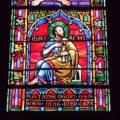by Trisha Bleau Smith
 The name Bible comes from a Greek word biblos. It means little books. The Bible is basically a library of little books. If you look at your Bible you will see that there are 66 books, unless you read the Catholic Bible which has additional books the Catholic church felt should have been included when the Bible was canonized.
The name Bible comes from a Greek word biblos. It means little books. The Bible is basically a library of little books. If you look at your Bible you will see that there are 66 books, unless you read the Catholic Bible which has additional books the Catholic church felt should have been included when the Bible was canonized.
Often you will hear it referred to as the Canon. It came from the Greek word Kanon, meaning rule or rod of measurement. The books in the Bible are ones that we measure ourselves against.
There are five questions asked by the church in accepting and rejecting books as canonical.
- Was it written by a prophet of God? Deuteronomy 18:18 tells us that only a prophet of God will speak the Word of God. There are also many ways of testing prophets of God outlined Biblically. We won’t go in to that here since that is not the issue at hand.
- Was the author confirmed by an act of God? Hebrews 2:3-4 gives us the idea that some miraculous confirmation will follow – Jesus had the resurrection the apostles continued Jesus’ miracles, etc. all confirming God’s message.
- Does it tell the truth about God? Agreement with earlier revelation is essential. This rules out false prophesies made in the name of God. Jesus referred to Scriptures, which was reference to the Old Testament teachings, numerous times. Many of the Scriptures were fulfilled, thus validating them as agreeing with earlier revelation.
- Does it have the power of God? The works had to exhibit a transforming power in the lives of the reader – it had to have major impact in to their lives (see any of the epistles and the power in those words to guide our walk for examples).
- Was it accepted by the people of God? Many of the letters and the Gospels were highly circulated in the early churches. The Old Testament is full of Scriptures that cite one another, thus showing they had been accepted earlier. The New Testament also shows this when Peter call’s Paul’s writings scripture (2 Peter 3:16) and Paul quotes Luke alongside a passage from the Law (1 Timothy 5:18). There are many other citations and proofs of acceptance among the Scriptures that were canonized.
What is interesting to note is the fact that never have there been ANY books that were once accepted and later thrown out. There is only the difference in the belief on books that SHOULD have been included – the apocrypha and the Gnostic gospels.
 The Apocrypha was written between the third century BC and the first century AD. It consists of 14 books. These books were never accepted by the Jewish people though and are debated amongst Protestants today. Early church leaders did accept these books though and later canonized them as Scripture, in essence adding these books to the existing Bible as we knew it. The books were never officially added to the Bible until the 1546 Council of Trent. Catholic Bibles were all translated from the Vulgate text with the addition of the apocrypha being added in after the death of Jerome.
The Apocrypha was written between the third century BC and the first century AD. It consists of 14 books. These books were never accepted by the Jewish people though and are debated amongst Protestants today. Early church leaders did accept these books though and later canonized them as Scripture, in essence adding these books to the existing Bible as we knew it. The books were never officially added to the Bible until the 1546 Council of Trent. Catholic Bibles were all translated from the Vulgate text with the addition of the apocrypha being added in after the death of Jerome.
What is interesting is that many of the Apocryphal books do not CLAIM to be inspired – some even specifically deny the fact. If God did not inspire it then it is NOT His Word, plain and simple. Hundreds and hundreds of books and manuscripts/parchments have been found over the years that show the books dating back to earlier centuries… but just because books were recorded, read, and circulated does not mean they were inspired and thus required for the Bible.
There is evidence for why antiquity did not accept Apocryphal books, as outlined by Geisler. Here are a few sample reasons why:
- Philo, an Alexandrian Jewish philosopher, quoted the Old Testament often, yet never quoted the Apocrypha.
- Josephus, a Jewish historian, excludes the Apocrypha although there are hundreds of quotes and references to almost all of the books that WERE included in the Canon
- Jesus and the New Testament authors never quoted the Apocrypha although there were numerous Old Testament quotes and references in their writings.
- Jewish scholars of Jamnia (AD 90) did not recognize the Apocrypha.
- No canon or council of the Christian church for the first 4 centuries recognized these books as inspired.
- Many great names spoke against these books – Origen, Cyril of Jerusalem, Athanasius, etc.
- Jerome, the editor for the Vulgate, rejected the Apocrypha as part of the canon. These books were later added to his version.
Here is a basic run down of the Bible we know today.
The Hebrew Bible is what is known today as the Old Testament in most Bibles. The Catholic Bible includes a few extra books not accepted by the Jewish people as Scriptural. The Old Testament is broken up in to three parts: The Law, the Prophets, and the Writings. The Law consists of Genesis, Exodus, Leviticus, Numbers, and Deuteronomy (often referred to as the Pentateuch). The Prophets fall into two subdivisions – the former prophets (Joshua, Judges, first and Second Samuel, First and second Kings) and the latter prophets (Isaiah, Jeremiah, Ezekiel, and the book of the Twelve Prophets – Hosea, through Malachi). The Writings consist of Psalms, Proverbs, Job, Song of Solomon, Ruth, Lamentations, Ecclesiastes, Ester, Daniel, Ezra, Nehemiah, and First and Second Chronicles.
 The Septuagint is an arrangement that most of us are familiar with today – it is what we see as the Old Testament. This is the pre-Christian Greek translation of the Old Testament. Sometimes the Writings can be broken in to historical books and poetry, but the rest remains the same as what was listed above. All New Testament quotes were taken from the translation of the Septuagint.
The Septuagint is an arrangement that most of us are familiar with today – it is what we see as the Old Testament. This is the pre-Christian Greek translation of the Old Testament. Sometimes the Writings can be broken in to historical books and poetry, but the rest remains the same as what was listed above. All New Testament quotes were taken from the translation of the Septuagint.
The Vulgate was the translation of the Bible in to Latin. The Old Testament was not considered valid in early translations because it was a translation of a translation rather than direct translation as was the case in the New Testament which was penned in Greek. The books that were included in the Catholic Bible are only in the Old Testament (unless I am wrong in this since I am not Catholic) are Tobit , Judith, 1 & 2 Maccabees, Wisdom, Sirach, and Baruch.
The New Testament begins with the Gospels and the book of Acts, a history of the early church. It is then followed by twenty one letters, or epistles. Thirteen of these are by Paul with the remaining 8 being the works of other apostles or authors associated with the apostles. Revelation is the last book, written by John.
This is just a short, overview of the Bible and the process that went in to selecting the books for inclusion. There are many debates over books that were included, books that should have been included, etc. as well as many different references, resources, and follow ups that can be done from this basic introduction. This was intended to give information only, not to prove or disprove any views or to try to alter your thinking or beliefs in any way. Seek God, trust Him, and He will reveal Himself to you through His Word or through other works available.
References
- Barnstone, Willis. The OTHER Bible. Harper/Collins, 1984. ISBN: 0062500309
- Bowker, John. Oxford Concise Dictionary of World Religions, Oxford University Press, 2000, ISBN: 0192800949
- Geisler, Norman; Brooks, Ron. When Skeptics Ask: A Handbook on Christian Evidences, Baker, 1990, ISBN: 0801011418
- Goring, Rosemary; Whaling, Dr. Frank. Lourousse Dictionary of Beliefs and Religions. Lourousse, 1992, 1994. ISBN: 0752300008
- Rosten, Leo. Religions of America: A New Guide and Almanac. Cowles Communications, Inc. 1952, 1953, 1954, 1955, 1963, 1975. ISBN: 0671219707
- Sproul, R.C. Now, That’s A Good Question! Tyndale, ISBN: 0842347119
- Wilson, Bill. A Ready Defense: The Best of Josh McDowell. Thomas Nelson, 1993. ISBN: 0840744196
- Youngblood, Ronald; Bruce, FF; Harrison, RK, Nelson’s New Illustrated Bible Dictionary, Nelson, 1986, 1995, ISBN: 0840720718





Be the first to comment